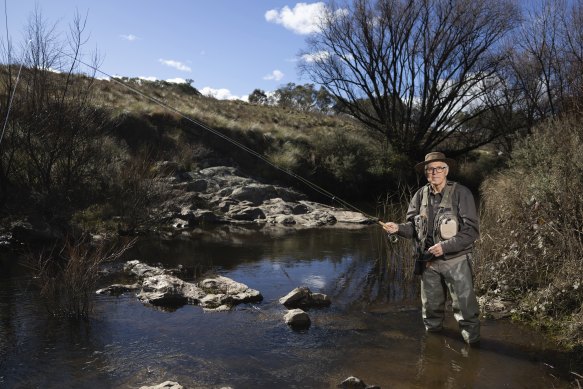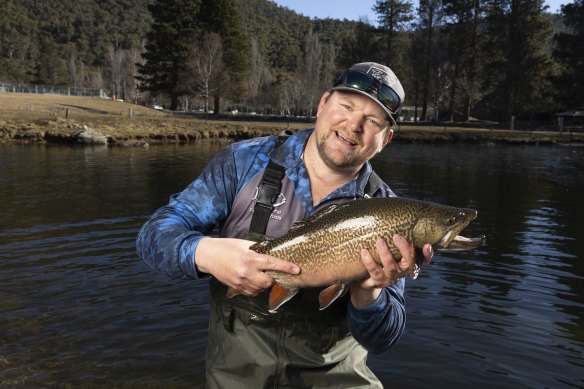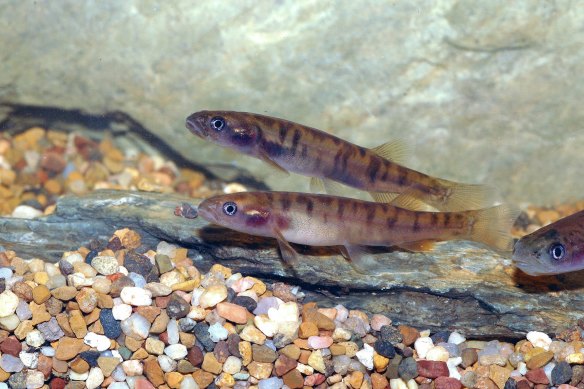This was published 6 months ago
Trout fishing on the hook for threatened species’ survival
By Mike Foley
Every year, several million trout fingerlings are released into the wild by the NSW and Victorian governments. Not all survive, but the goal is to build a population for anglers to enjoy. Most go into man-made lakes, but fishermen prize the wild streams where they can stalk the banks in what many regard as the most exciting form of freshwater fishing.
But the arrival of these trout is a disaster for a species of tiny pencil-sized river fish, the galaxiids, which are now on the frontline of Australia’s extinction crisis. Ensuring their survival threatens to derail a 150-year-old tradition of trout fishing.

Guy Verney, a member of the Monaro Acclimatisation Society, casting a fly for rainbow trout in Yandyguinula Creek. Credit: Alex Ellinghausen.
Fishermen proudly declare their credentials as river managers. They lobby for the removal of feral horses from the Alpine regions where trout thrive, are major regional economic contributors and stakeholders for a healthy environment, and have more at stake than many people who seldom venture into nature.
The competition between trout from the northern hemisphere and native galaxiids epitomises the clash for resources in the bush. The galaxiids’ home, typically in small freshwater forest and mountain waterways in the country’s east, overlaps with prime trout country.
In August last year, the NSW Department of Fisheries ruled that a handful of popular trout fishing waterways around the Snowy Mountains would not be stocked with trout because a galaxiid species, the redsnout galaxias or galaxias terenasus, had been deemed endangered by the federal government – trout were listed as a key threatening process.
Essentially, this means governments must take steps to mitigate the impact of introduced trout on native galaxias. Even if the NSW Department of Fisheries does not restock trout streams to protect galaxias terenasus in its native habitat, the species is found in prime trout-fishing streams: Cambalong Creek and major stretches of the Snowy, Delegate and Maclaughlin rivers.
So-called acclimatisation societies, whose members strategically bred and released european species from the mid-1800s onwards in an attempt to cultivate a European landscape, released many of the northern hemisphere species now found throughout Australia.
The Monaro Acclimatisation Society, founded in 1937, is still going strong, with about 20 branches from Yass to Tumut on the edge of the Snowy Mountains. Trout can breed in Australian streams but because they are not adapted to drought, the rivers need to be restocked with a fresh batch of hatchery-bred fingerlings to become a viable fishing target.
The society’s president, Kerry Pfeiffer, contests the need to scale back restocking and is concerned about future moves that could restrict trout fishing streams even further.
“Yes, trout are introduced, I accept that they are an environmental issue and we need to manage that. But they are also serving a social purpose and so long as we manage it well, and we consider things like galaxiids and we find ways for them to survive, I can’t see why it should be stopped,” Pfeiffer said.
He contends that the worst damage from trout to native species occurred when the species was introduced in colonial days, and there are ongoing impacts from habitat loss and farming. Fertilisers affect water quality and livestock trample river banks, raising sediment levels in the streams and making it harder for galaxiids to survive.

Manager Mitch Elkins with a tiger trout, at the Gaden Trout Hatchery in Jindabyne, NSW. Credit: The Sydney Morning Herald
The path forward, he says, is to continue stocking trout but also invest in survival programs for galaxiids, such as breeding and stocking them in refuge areas – stretches of river trout can’t reach, such as the streams above waterfalls.
“We need sanctuaries for them and we’ve got to invest money into fencing off stock and making sure that there’s a riparian zone with vegetation along river banks ... then we can have thriving populations,” Pfeiffer said.
The Monaro Acclimatisation Society wrote to the NSW government in April: “It is our considered view that as these native fish and trout have co-existed for some 130 years, that solutions where both can continue to cohabit within the Snowy River system are possible and need to be explored.”
There are about 1 million recreational fishers in NSW and more than 800,000 in Victoria. Thousands regularly enjoy walking mountain and forest streams angling for the aggressive, hard-fighting brown and rainbow trout.
Conservationists and biologists say introducing European species into Australia’s fragile environment is an anachronistic practice that must be significantly scaled back if galaxias are to survive.

The elusive Yalmy galaxias, which grows to the length of an adult’s finger.Credit: Tarmo A. Raadik
In April, conservation groups wrote to federal environment minister Tanya Plibersek demanding urgent action to save the Yalmy galaxias in the lower Snowy River and its tributaries in east Gippsland. The habitat was devastated by the Black Summer bushfires and a survey in March 2023 found just 20 examples of the fish.
“Native galaxias fish are some of Australia’s most threatened species, with 14 assessed as having at least 50 per cent chance of becoming extinct in the next 20 years,” said Biodiversity Council director James Trezise.
“In evolutionary terms trout are a new arrival, being dropped onto the continent one second before midnight compared to the native species that have lived here for millions of years.”
Trezise said it was “self-defeating” for government environment departments to work to save galaxiids while fisheries agencies were introducing feral species that prey on them.
“Invasive trout are one of the biggest threats to Australia’s native galaxias and we shouldn’t be adding to the problem by continually stocking our waterways with trout.”
Guy Verney, a retired public servant and local Landcare volunteer who lives in Canberra, is a keen trout fisherman in southern NSW and a member of the Monaro Acclimatisation Society.
He emphasised the social importance of trout fishing and is concerned that governments might introduce restrictions before compromises are sought.
“My view is you’ve got to communicate and talk about these issues and understand what is at stake for all sides,” Verney said.
“All groups have to be party to that. It just can’t be one side, you’ve got to talk it through and work out if you can find a balance or not.
“Fishing involves the exercise that people should be doing, walking [in the] fresh air and experiencing the environment.”
Verney said for example, a local club, the Australian Capital Territory Fly Fishers, runs the Casting for Recovery program for breast cancer survivors.
The NSW government wrote to the conservation advocacy group the Invasive Species Council in May, stating it was mapping galaxiid habitat and the distribution of trout in the southern half of the state to “identify suitable trout-free habitat”.
NSW Department of Primary Industries said stocking locations were reviewed annually. Trout were “stocked into the most suitable locations for recreational anglers, and important threatened species are protected”.
Plibersek also wrote to the council in May, confirming she had asked state governments “to urge them to take action to protect our native freshwater species”.
The council’s principal policy analyst Carol Booth said her goal ultimately was to prioritise survival of all native species, but even for free-flowing prime trout streams “that’s not incompatible with what will continue to be thriving fishing opportunities”.
However, human impacts must be scaled back, Booth said, given Australia’s native species losses have continued on a steady trajectory since colonisation and galaxiids were among the next most likely next species to disappear.
The Monaro group’s Kerry Pfeiffer says Australia’s harsh environment, coupled with increasing fears for native species survival, spells more uncertainty for trout fishing.
“I don’t know what’s in the future. If we go through some horrendous droughts and bushfires and things like that, I don’t know what things are going to look like coming out the other side,” he says.
Cut through the noise of federal politics with news, views and expert analysis from Jacqueline Maley. Subscribers can sign up to our weekly Inside Politics newsletter here.